I can’t help it. I love this piece of old goldwork embroidery on velvet! And I want to show it to you!
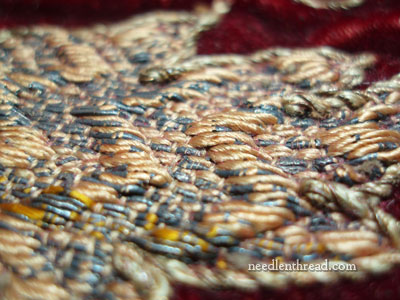
The funny thing is, I didn’t start loving it truly until I started looking at it closely. The more I look at it, the more I love it! And the more I look at it, the more I think about it and want to know more about it.
Before talking nitty-gritty details, I just want to show the piece to you and point out things that are noticeable about it on the first approach. If you have any questions about it, or you have any input on it, you are welcome to join into the discuss by leaving a comment. Maybe your questions can prompt me to explore the piece in directions I wouldn’t have thought of!
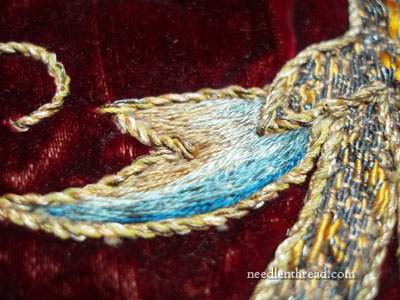
I don’t know how old this piece is, and I don’t know anything about the history of it.
I do know that all the goldwork threads are now a blue-ish grey, but most of the silk threads still retain their color, though perhaps not as vivid as their original color.
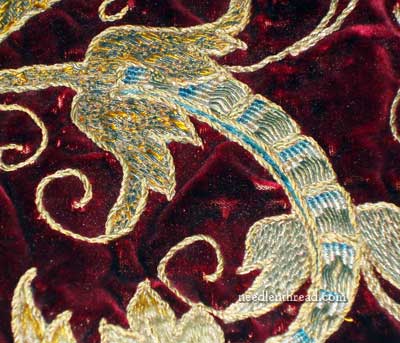
I know that the piece contains many well-executed examples of couched goldwork threads. I know that it doesn’t feature any purl, bullion, chip work, or the like. All the metal threads are couched, even in areas where chip work with purl or bullion would have made sense.
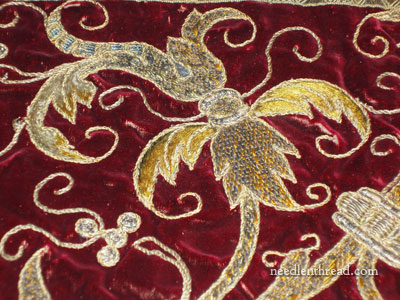
I know that, although all the threads are couched, they aren’t all the same kinds of threads or the same couching techniques. Several types of metal threads have been couched in myriad ways to create contrast, texture, and interest.
And I know that, if the goldwork threads were intact now, the piece would be a-dazzle with the gleam and glitter caused by those various techniques reflecting light in different ways. The piece, in its original state, must have been sumptuous.
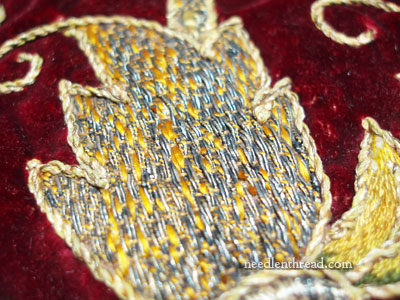
I also know that the cores of the various couched threads are silk, and that the core threads are different colors. There are bright yellow cores, pale peaches, soft greens. These are the cores of gold passing threads, rococco, and the like – the cores would not normally have been exposed, except for the age and wear on the piece. But in their exposure, a different type of beauty is revealed.
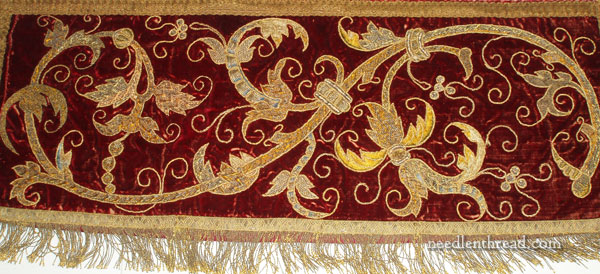
What else does a first encounter reveal about the piece? (You can click on that photo above for a slightly larger version.)
That it was (most sadly!) cut from a larger piece. It looks like a side panel or front panel of some larger textile – maybe a fancy sideboard cloth, or an altar covering, or a canopy, or something. The cut is right across the top of the piece, above the gold braid. (I since discovered it was the decorative valance on a “half tester” bed – probably 15th / 16th century or thereabouts.)
That it is trimmed with fringe made from real metal threads.
That is is very heavy for a relatively small piece (10″ x 27″).
That the design used was drawn to fit within the size of that portion of whatever larger thing the piece comes from. The embroidery hasn’t been salvaged from something else and adjusted to fill up that space – it actually was drawn to fit the space and embroidered within that space.
So that’s what I know about the piece after a first overview.
Does the piece prompt any questions in you? If you were looking at it up close, what would you want to find out about it? What would you want your examinations to reveal to you? Feel free to ask away, and I’ll do the poking and prodding to see if I can find some answers!







My question: was the embroidery worked directly onto the velvet? And if so, how did the embroiderer stop the velvet pile showing between the stitches? (OK, that’s two questions…)
What a splendid piece this must have been when the gold thread was gleaming and new. I love the rich red velvet background.
How was the design transferred to the velvet or is it frrehand?
What type of needle was used taking into considered the thread and the
Velvet.? what do you think was the purpose of the piece?
While the threads are worn, it looks like the piece has otherwise held up well for it’s weight. Can you tell what type of support system was used–backing, interfacing, etc.? Was it stitched directly onto the velvet or separately and applied? (from your comments, I assume for fomer.)
Thanks for sharing this!
Mary– this looks very much like a piece of ecclesiastical embroidery belonging to a synagogue–maybe part of a wedding canopy or even a torah scroll cover.
It has also motivated me to look more closely at some of my gold/silver work on both the Challah cover( cover for bread) , tallit bag ( bag for prayer shawl) and Scroll mantles in our Ark at Synagogue. ( not meaning that i have amde them but they are bought items and I dont know their provenance. If you want to know more about any of these items please feel free to ask. Hele in Perth Western Australia
Hi Helen,
thats very interesting. Could you post a piccy to show us an example of synagogue embroidery?
I am fascinated!
thanks Jean.
Piękny kawałek haftu, jak również historii.
Sadly? Maybe. If that was what was left from a larger, heavily damaged (such as fire or flood) instead of just chopped up heartlessly, it would likely be a happy thing, since they saved SOME of the pretty pattern instead of just tossing the entire thing. Since none of us know the history behind the piece, we can’t say whether it is a sad or happy thing. I don’t care much for the color red, but it is a lovely, old-fashioned pattern. Have you considered sending it to an expert to find out exactly how old it is? Some places might be able to tell you.
Is the velvet cotton? Silk? I don’t know why but theatre costume or prop comes to mind. An e
This is a beautiful piece, I truly love anything with that curly-q design. For being so old, and having such heavy embroidery, it seems odd to me that the fabric has not torn. But I agree, the loss of some of the gold has revealed a whole new beauty. I’m not sure what I’d use it for, I wouldn’t want to set things on top of it. I had a thought of having it framed, but then you’d be denied that occasional touch. I don’t know, but it sure it beautiful!
Hi,
wondered how old this is – looks a bit tudor in design.
Also do you know the country of origin
thanks
Jean
Sorry, Got cut off. Was going to say it also looks like the bottom of an eccliastical banner … the type held aloff in a procession.
Good group of questions are coming in! Detective work is so interesting. Do you know ANYthing about where it came from? — where did YOU get it? I don’t know why, but it strikes me as being very old. Relies on excellent technique (as opposed to a variety of materials) and expensive stuff (the weight of the metal threads). Ecclesiastical is always a good guess here. Is the velvet silk? Any clues from ground fabric itself? lining? backing? padding? Is the embroidery padded with anything? card? fleece stuffing? or padding threads? Keep us all in the loop, please.
Hi, Bobbi, I got it from Larissa, who is in Russia, but she got it on EBay, from England. That’s all I know about the origins, really, but it’s a fun piece to examine! MC
I can’t imagine why anyone cut that. It looks magnificent even in it’s worn state. You sure are good at being a detective related to embroidery Mary.
Mary,
To me it looks awfully like part of the top canopy from a tester bed.
This is what I got from what you got. The piece, being cut away from another larger piece, may indicate, that this was the only salvageable area in a ruined piece. Which is sad, but if there were portions, of say mold on it, I can see why they would cut out the best, and toss the rest. Somebody really wanted to practice couching, or perhaps, it was the only stitch, they felt confident in working with gold. I love the idea of fitting a design into material you have at hand. Which made me wonder, if the artist that did the work, was it their own design, and that is why they fit the design into the piece? or they liked a portion of some other design, and just picked out what they liked. So many what if’s! Thank you for sharing that beautiful piece.
This piece looks very similar to several pieces I have seen that are dated to the 16th century, mostly from Italy or the Netherlands. One example is at the Los Angeles County Museum of Art (here: http://collectionsonline.lacma.org/mwebcgi/mweb.exe?request=record;id=66538;type=101 ) The pieces are ecclesiastical in nature, sometimes parts of vestments, sometimes altar frontals, etc. The techniques are very similar to what your piece has- mostly couching, but often little bits of other things. I believe the gold might have turned grey because it is “silver gilt” and the “gilt” part has worn off, allowing the silver to show through and tarnish. Your piece looks to be in about the same condition as the ones I’ve seen, as well. Usually these pieces are embroidered on linen, and then the linen embroidered bits are appliqued down onto the velvet. Chipwork/purl work/bullion work was not in common use until a later period, although sometimes you can find small amounts of it in pieces like this. Very often pieces like this were cut up and re-purposed at a later date- vestments were recut to the latest fashion, altar frontals resized or re-used as wall hangings, etc. Sometimes the embroidery was even moved from one backing fabric to another. If this is the original velvet it would be a silk velvet. Such a beautiful piece!
Hi Deborah,
that really is a similair piece of work! I just had to check out the date for the reign of the English Tudors ; it was 1485 – 1603 which ties in with your example. I had been thinking of the latter period. It was a time whene merchants were oing a lot of to and fro-ing, so I can see where the Netherlandic or Italian influence in the style fits. Just as a guess I would favor the Netherlands.
jean
Were the silk thread cores exposed on purpose? The exposure looks awfully .. patterned. (and lovely!).
I’d love to see your comment
“although all the threads are couched, they aren’t all the same kinds of threads or the same couching techniques. Several types of metal threads have been couched in myriad ways to create contrast, texture, and interest. ”
expanded.
I love the way the couching stitches sink so beautifully into, and marry with, the couched silk threads (apparent in the first and second photos).
It is so regal. I guess I am wondering: how many people did it take to do this and how long would it take? It wasn’t worn by anyone was it? You said it was very heavy so probably not? I wonder if it was part of a curtain used on a canopy bed?
My Questions would be.
What sort of velvet is it, velveteen, backed. thick thin?
How would you transfer a design on to it – pounce?
The piece itself inspires me to try working with velvet, I could just see a tudor rose appearing on black.
What method do you think was used to mark the velvet with pattern lines??? Thanks Gail
Not seeing it up close I will has as a guess that it is silk velvert as it has stretched to give, over time a crumpled look, or the embroidery has shrunk and tightened. The former I’d say.
In saying that more the weight of the embroidery has caused the ground fabric to stretch. Even if it is backed hanging would put a lot of stress on the whole.
It could be religious.
Hi Mary
I was going to agree with Lesley-Anne, but it isn’t large enough. Helen’s idea that it belonged to a wedding canopy could be spot-on as it appears to feature a wedding band or two(?) holding the vinelets together. It’s amazing that the one technique I would have worried over – the metal fringe – has lasted so well. Do you think it was added later?
Hi Catherine,
that sounds like an interestingidea,
The piece suggests to me that it had a second half which repeated the symmetry. I am working on an copy of an icon from an illuminated book of hours from the middle (14c)ages, and every now and then the vines which surround the images are cinched or enircled in this way. I think what you suggest are wedding bands maybe just a stylistic convention.
Jean
Mary–you are the home run queen of embroidery!
WOW, another stunner–is this from your friend in Russia? Could we see the back please?Working on velvet is squirrely to say the least, so seeing what’s what on the back might help us understand how/when it was crafted.
Could we deduce anything from the fact that the lovely design is asymmetrical?
Thank you for sharing!
My questions are more general
How old is it?
Where is it from (country or region)?
Can you tell if more than one person worked on it?
How do you happen to be studying it?
Hello Mary I just love receiveing your letetr every day it is so inspirational. Could you possibly to a tutorial of gold work on velvet. It is over a year a few of us embroidary ladies in Johannesburg South Africa have wanted to do a project. The problem is we don’t know how or where to start. How does one not flatten the velvet, does one work without a loop. Sorry about all the questions.
I love the design & presume that the embroidery was done as a slip. Is this so?
Hi Jean
Thank you for your comment about what I thought might be wedding bands. However, that you are working on an icon from an illuminated Book of Hours from the 14th century has me more than doubly impressed. What a fabulous project!
Hi Catherine,
Its a fabulous book actually – called !Les Belles Heures de Jean Duc de Berry – worth looking up if you can.
BTW, thank you for your kind thoughts, if you could see my embroidery skills though, you may be less impressed….(lol!)
que maestria me encanta…especial para un cuadro con textura y diferentes puntadas
me faszino
gracias Mary
Hmm, what kind of lining is on the back? What are the dimensions? I’m not quite awake this morning (reading while enjoying morning tea) but the design seems to remind me of a valance on a heavy bed curtain I saw in England.
Oops, saw the dimensions after I posted. Probably not a valance, unless for a very wealthy child/doll house.
Hi Dia,
you may be closer thatn you think, if you have ever visited Dover Castle (?) The suits of armour are quite tiny. People those days averaged aroun 5′ 4″ I think.
so if it were half of a symmetrical piece – the over all length woul dbe 54″.
Might have been part of a canopy from a 4 poster bed!
Jean, the beds were short because they slept sitting upright. A superstition about dying whilst asleep. It is a beautiful piece of embroidery.
Hi Melody,
Good point! I’d forgotten about that. They were afraid evil spirits would suffocate them by standing on their chests – sleeping upright also served as a deterrant against mice jumping down their throats if they slept with their mouths open.
So it could well be off a bed canopy then, given that they were small and slept upright – ish.
Might be from a medieval lampshade though…(just kidding!)
Mary, You always have such interesting things to look at. I was wondering if the embroidery has a topper under it to stabilize the thread and keep the velvet from showing through or is it just very densely stitched. Apparently, I am not the only person with this question.
Thanks again for showing us possibilities for using our patterns.
Debbie
Dear Mary
Beautiful imagine what it was like when new. I wonder what it was made for? or who made it how old is it, it has still retained some of it’s former glory, lovely.
Regards Anita Simmance
Gorgeous! but:
Think REVIVAL. Think INFLUENCE .
At first and second glance, I think it’s 19th century c. 1870 – 1899 based on 1. condition which appears pretty darn good (few loose, frayed, lost, pulled floss; little wear to the velvet, couching appears pretty intact, fringe intact). Knowing the backing would be helpful (is it white glazed linen? Is it bucram or similar?).
Any way, I’m thinking Renaissance revival of that period especially in England; and I do think your piece is English; the designs of which influenced Pugin, Dresser, Morris, and Owen Jones. Morris loved renaissance design and adapted it to ecclesiastical and secular needlework he taught to students as well as his own wife and daughter who excelled in it.
And I see you are aware of the Royal College of Needlework who produced great stuff like this!
PS, Also I’d love to see more of the trim – the band at top and bottom, as well as the fringe which help clear up the mystery. if the band is machine made it could TOTALLY illuminate things.
On second look I think the floss and velvet just too pristine to be 16thc.
Still lovely, though and perhaps no less important if RCN or other.